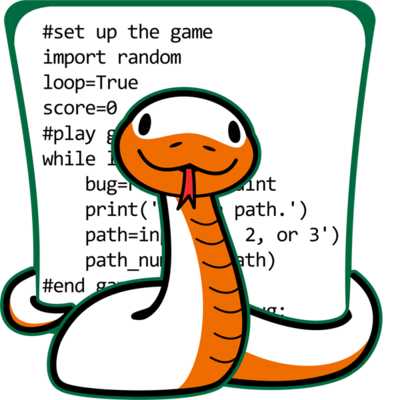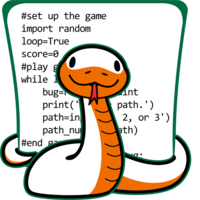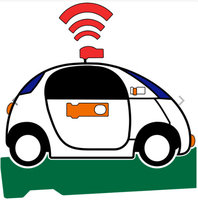TechnoKids TechnoPython

Description
Session 1 Into the Coding Jungle
Students explore the Coding Jungle. The goal of this mission is to learn about Python, which is a text-based programming language. To start, the explorers are introduced to terminology by experimenting with code. Once familiar with the role of a programmer, they play a Python Hunt game and then edit the program to discover how it works. Afterwards, they break code in the Catch the Bugs game to develop essential debugging skills. Successful completion of the four-part mission requires curiosity, which is a highly valued trait in a programmer.
Session 2 Pet Monster Rescue
Students create a program for the Pet Monster Rescue, which is a group that finds loving homes for monsters. To prepare for the programming mission, students learn about strings, integers, and variables. They apply this knowledge to personalize the adoption process. To pair a pet owner to their monster, the programmers write code that ask questions. The answers are used to match people to their ideal pet. This is done by combining logical operators, if and else statements, and a variable that changes from True to False. Throughout the four-part mission, an emphasis is placed upon thinking logically, which is an ability every successful programmer needs.
Session 3 Guess It Game
Students design a guessing game in which the player must correctly pick a number before they run out of chances. Clues tell them if their answer is too high or low. This programming mission has six parts. To prepare, students first explore how to code while and for loops. Once familiar with how to repeat a set of instructions, they start to build Guess It. To guide development, the Python programmers sequence steps into algorithms. These flowcharts provide a framework for constructing each part of the program. Fun challenges encourage students to build a unique game. Interwoven throughout all tasks is a focus upon being methodical. This skill helps programmers test different cases to solve problems within the code.
Session 4 Adventure Quest Part 1
Students develop a text-based adventure game. It is a quest that has players overcome challenges to earn rewards. To prepare for this programming mission, students learn techniques to standardize data entry. Next, they apply these skills to build the first part of their game. It will allow players to pick a direction to explore. It will also include a challenge whereby the player can win coins when they travel North. To complete the task, students must be persistent. What will happen in this strange land?
Session 5 Adventure Quest Part 2
Students complete their text-based adventure game. They develop a treasure hunt that has players travel East to collect objects. They must avoid danger, or risk losing it all! To prepare for this part of the programming mission, students learn about lists. They add, remove, sort, and count items. Once this skill is mastered, they apply it to their quest. Throughout the activities, an emphasis is placed upon creativity. This trait is essential as it allows programmers to design original programs.
Session 6 Coding Presentation
Students share their favorite Python program in a coding presentation. They demonstrate how the game works and explain the code. This provides an opportunity to develop strong communication skills, which help programmers do their job.
Optional Python Lessons with Programming Challenges
- Find and Fix the Bugs: Debug the code to read the silly sentences.
- Loop the Questions to Try Again: Write if and else statements in a nested loop.
- Pet Monster Picture: Use a Python library to open an online image.
- Keep Score: Track the number of correct guesses.
- Game Test: Research the user experience.
- Create a Map: Illustrate the land in the adventure game.
Python Lessons for Beginners - Programming for Kids
In this STEM project, students complete missions to develop Python programming skills. To start, they play a Python Hunt game to discover how the code works. Next, they break the Catch the Bugs game to acquire essential debugging skills. Afterwards, they gradually build their skill set by creating Pet Monster Rescue, Guess It, and Adventure Quest games. Each session includes reviews and skill reviews to assess knowledge, practice skills, and encourage the transfer of learning to new contexts.
- Apply programming skills to complete coding challenges
- Plan and organize ideas to develop a program
- Debug errors to find and fix a mistake in a script
- Test multiple responses to verify the output is correct
- Reflect upon program development in a coding presentation
- Demonstrate logical thinking, creativity, and persistence
- Create variables to store, report, and calculate information
- Loop a set of instructions and control how or when it ends
- Write if statements that are based on conditional logic
- Import Python libraries and use their commands
TechnoKids TechnoPython
- Publisher: TechnoKids
- Grade Level: 6-9
- Platform: Win
- Item #: INT-PYTHON
We will honor all current TechnoKids promotions!
| TechnoPython #INT-PYTHON |
Price: $49.00 |
Features and Benefits
Session 1 Become a Programmer
Students are introduced to programming. They design animated scenes using Scratch. To start, they learn about the importance of computer programs and technology in daily life. By answering a series of questions, they begin to think like a programmer. Afterwards, students study the Scratch interface to label the parts. Once familiar with the environment, they discover how to stack blocks of code together to form a script that makes a character talk. Once they have mastered some of the basics, they explore the Scratch libraries to make a scene of two friends having fun.
Session 2 Build an Aquarium
Students create their first project for the Activity Studio. It is an animated aquarium. To start, they explore Scratch Motion blocks to discover how they can be used to make sprites move across the stage. Next, they learn how to use the Paint Editor to design a fish tank that has a custom backdrop. Afterwards, students use forever and if then blocks to control the fish swimming. To practice coding skills, a list of challenges provides a creative spark. Upon completion, the project is prepared for viewers. Students are then given the option to share the file with the Scratch community and classmates.
Session 3 Design a Maze
Students create their second project for the Activity Studio. It is a maze game. This activity provides an opportunity for students to practice coding skills from Session 2 to solidify their learning. To start, they complete a planning sheet to organize their ideas. Next, they use Scratch to create a puzzle that has players help a character find a way to the end of a path using arrow keys. To make the project unique, a list of challenges helps to make a one-of-a-kind maze. Upon completion, the game is prepared for players.
Session 4 Broadcast a Story
Students create their third project for the Activity Studio. It is an animated story about a magical place. To start, they explore the Looks blocks to discover how they can be used to change the appearance of the main character and setting. Next, they enhance storytelling by triggering actions to occur when there is a switch in the backdrop. Afterwards, they direct the timing of events by sending messages to sprites using the Broadcast blocks. To practice coding skills, a list of challenges provides a creative spark. Upon completion the project is shared with viewers. Students are then given the option to ask a peer to review their story using a checklist.
Session 5 Engineer a Game
Students create their final project for the Activity Studio. They apply their coding skills to develop a game. To start, they use a planning sheet to determine the objective, scoring system, timing, and coding structure. Next, they discuss their design with a partner to assess if it is suitable for young children. Afterwards, students follow instructions to build and test the code. Challenges are included to foster originality. Upon completion, the project is prepared for players.
Session 6 Curate an Activity Studio
Students build an Activity Studio for kids. It will have a collection of Scratch projects including an animated scene, maze, story, and game. To gain player feedback a link to the studio will be shared. Based on observation and questioning, students will make recommendations upon how they can improve their Activity Studio.
Optional Scratch Lessons with Coding Challenges
- Dance to the Beat: Sequence motion with sound.
- Draw Artwork: Understand coordinates by drawing with the pen.
- Invent an Instrument: Edit sound clips to compose music.
- Build an Interactive Diorama: Share facts about nature or an historical event.
- Develop a Treasure Hunt: Find the hidden items in a scene.
- Chat with a Sprite: Use variables to talk with the computer.
- Remix a Scratch Project: Create something new from an existing project.
Scratch for Beginners - Programming for Kids
Spark an interest in computer science! In this STEM project, students become coders that design a fun Activity Studio for kids using Scratch. Through discovery and exploration, they learn how to create a series of hands-on activities that children will enjoy playing.
- Apply computational thinking to tackle problems
- Plan and organize ideas to develop a program
- Build scripts to produce an animation, game, or story
- Debug errors to find and fix a mistake in a script
- Reflect upon program development using a coding journal
- Set the appearance and movement of a sprite
- Trigger a script to run using multiple methods
- Control when or if actions happen using conditions
- Create variables to track game play such as score or timer
- Direct the timing of events using broadcasting







